Pakistan Cricket Shame, Floods Disaster Maximum Point of Market Pessimism Is Coming For Investor Opportunity
Stock-Markets / Pakistan Aug 30, 2010 - 03:18 AM GMTBy: Submissions
 Bilal Khan writes: Pakistan was again in the news over the weekend but not for the recent floods. Its cricketers were in the headlines and for all the wrong reasons. Commenting now on an ongoing investigation would be premature and would only be fair after the authorities have conducted a comprehensive investigation. However one comment that can be made is that it will further erode what ever credibility the country had left after decades of blatant corruption by its leaders and will make donors already reluctant to give to Pakistan shy away further.
Bilal Khan writes: Pakistan was again in the news over the weekend but not for the recent floods. Its cricketers were in the headlines and for all the wrong reasons. Commenting now on an ongoing investigation would be premature and would only be fair after the authorities have conducted a comprehensive investigation. However one comment that can be made is that it will further erode what ever credibility the country had left after decades of blatant corruption by its leaders and will make donors already reluctant to give to Pakistan shy away further.
We begin this investment note with a quote from a man who made a fortune buying in the panic that followed the Battle of Waterloo against Napoleon in what remains without doubt one of the savviest investments in stock market history.
“The time to buy is when there's blood in the streets, even if the blood is your own." This quote is credited to Baron Rothschild an 18th century British nobleman and member of the Rothschild banking family.
The streets of Pakistan have been soaked in blood ever since we have stood united with the world in the “War against Terror” in the aftermath of the 9/11 atrocities. More recently Pakistan’s woes have been compounded by the devastation of a natural disaster that the U.N. Secretary General Mr. Ban Ki-moon has said is the worst he has ever seen.
This is a brief note to give you an update on Pakistan, our fund The Pakistan Opportunities Fund “POF”, the first and only USD denominated Pakistan country fund and why we believe you should be allocating a small portion of you investment portfolio to this potential double bagger. As I am sure you are aware Pakistan has recently been hit by its worst ever natural disaster. Flooding on a massive scale has left around 20% of the country under water and 14mn or 7% of the population without adequate food and shelter. The U.N has rated the floods in Pakistan as the greatest humanitarian crisis in recent history with more people affected than the South-East Asian tsunami and the recent earthquakes in Kashmir and Haiti combined.
How do stock markets behave after massive natural disasters? Well we don’t have to go too far back in history to find out. Cast your mind back to Boxing Day in 2004 when an undersea mega thrust earthquake measuring 9.1 struck just off the west coast of Sumatra, Indonesia triggering the Asian Tsunami which caused massive devastation in Indonesia, Sri Lanka, India and Thailand the worst hit. Also we have the October 2005 Pakistan earthquake when a major 7.6 earthquake hit Pakistan controlled Kashmir.
Whilst initial thoughts would have been that the affected countries would be devastated for years to come, the reality in fact could not have been more different. This investment note makes a strong case for learning and profiting from the wisdom of Baron Rothschild and why you should be looking at Pakistan through the eyes of a contrarian investor.
Pakistan is amongst a handful of markets that remain in long term bull markets and allocating funds to countries affected by cataclysmic disasters can give your investment portfolio a kicker. The case focuses on:
- How the stock markets of countries affected by natural disasters behaved in the aftermath
- If there is a bull market anywhere in the world it is in South & East Asia
- How over the last 12-yrs Pakistan has out performed nearly everything else in your portfolio in USD terms
- How Pakistan performs after periods of maximum pessimism
- Why you should allocate at least 1% to 3% of your portfolio to Pakistan around the 8,500 level
The chart below shows the main stock indices for the countries worst affected by the 2004 Asian Tsunami namely: Indonesia, Sri Lanka, India and Thailand from the start of their multi decade bull markets around 2000 to date. The red horizontal line shows the timing of the Asian Tsunami.

With the benefit of hindsight buying a country fund in the aftermath would have been a contrarian and very profitable investment decision. It is only after the event and way after the easy money has been made that investors look back in anger at the missed opportunity. After the event economists will emerge and explain what the driving force was and why the market rallied, but to make money, which is and will become increasingly difficult to make, it is too late. What matters is how you think and behave in real time. The fact of the matter is buying at a time of maximum pessimism is very difficult and few have the courage of conviction to buck the trend and buy when there really is blood on the streets.
The very countries which were worst hit by the Asian Tsunami are amongst the first markets to recover their losses from the 2008 Credit Crunch Crash. It is these very markets that are amongst the best performing in CY10 and have investors clamoring to invest in them. Why did these markets rally? Well simply because they are in secular bull markets. Who would have thought this possible at the dawn of 2005?
If we look at global stock markets on a relative strength basis obviously you would want to be in markets that fall the least when it was time to correct and rally the most when it was time to move on up. When asset prices collapsed in 2008, developed markets fell all the way to their 2000 lows whilst Asian markets only fell to 2003 – 2004 levels. When asset prices reversed, developed markets were no where near their respective all time highs, Asian markets however were closer. This point is clearly illustrated in the following table which shows the returns for various assets in CY10.
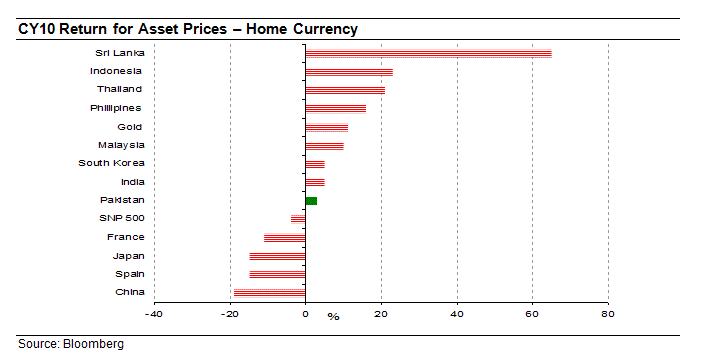
All asset prices rebounded strongly in 2009 but in 2010 most asset prices haven’t done much, the exception is South East Asia. If there is a bull market anywhere in the world it is in South East Asia.
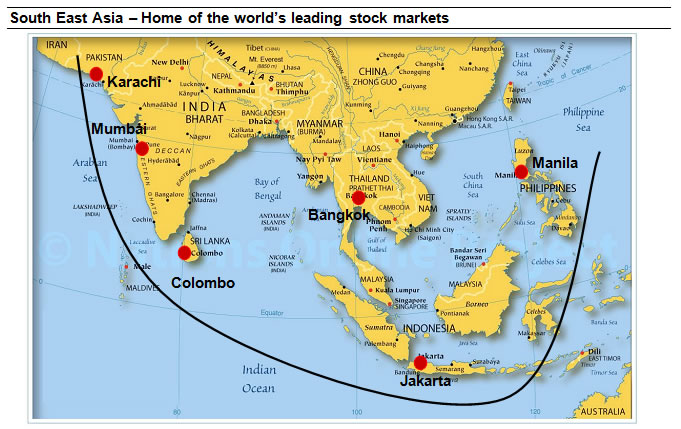
Source: Nations Online Project
The map shows the South East Asian markets which account for more than ¼ of the world’s population and the fact is that these markets, on a relative strength basis are the leading stock market in the world. Now in the years to come when Pakistan is amongst the best performing markets in the world and investors from the US, Europe, China and Japan are throwing their money at us in an effort to get a piece of the Pakistani bull market, remember this lonely voice.
Pessimism and Pakistan fortunately for the smart investor go hand in hand making this market a contrarian investor’s paradise. The following chart clearly shows this, it shows what would be the current value of USD 100 invested in various assets over a 12yr period. The results may surprise you. Pakistan outperformed: MSCI India, MSCI BRIC, MSCI EM, MSCI World. Pakistan even outperformed gold. So while the world has been busy focusing on the negatives and pessimism as well as billing Pakistan as the most dangerous country on earth contrarian investors have banked some serious coin.
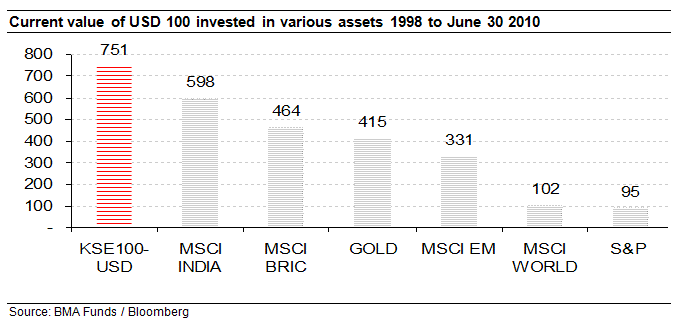
The following chart further highlights Pakistan’s contrarian history. We have highlighted the periods of maximum pessimism when the majority of the global investment community had written Pakistan off and how Pakistan’s stock market has risen from the ashes and given serious returns.
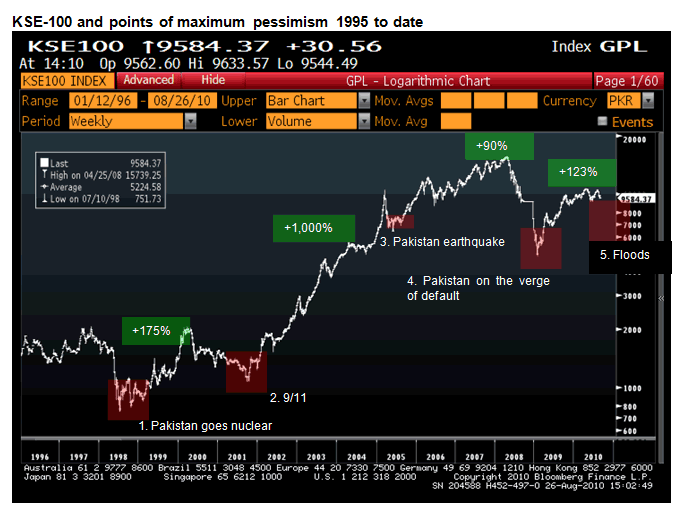
Times of maximum pessimism have been great buying opportunities in to Pakistan’s secular bull market that has many more years of climbing the wall of worry ahead of it.
Points of Maximum Pessimism
Number |
Date |
Event |
Consequence / Impact |
1 |
28/05/98 |
Pakistan goes nuclear |
|
2 |
09/11/01 |
9/11 attacks in NYC |
|
3 |
08/10/05 |
Pakistan earthquake |
|
4 |
Q3 2008 |
Pakistan on the verge of default |
|
5 |
Q3 2010 |
Pakistan floods |
|

- KSE-100 has again been on a stellar run since bottoming at the start of CY09 @ 4,800 and had rallied +123%, topping in April CY10 @ 10,731
- Recently price action has softened and is currently -11.4% off its April high
- Pakistan remains amongst a handful of markets that are positive for CY10
- Additional weakness should develop in the months ahead and all the stars are lining up for a major buying opportunity at the point of maximum pessimism estimated to be in Q410 or Q111
- Once the bottom is in, which we believe will be around the 7,500 – 8,500 level the stage will be set for Pakistan to rally through its 2008 high and new all time highs.
The following chart is our long term wave count for how we believe price action will unfold in Pakistan. It shows historical data from 1992 and has our projection in to the future. According to the chart Pakistan’s secular bull market still has a long way to go.
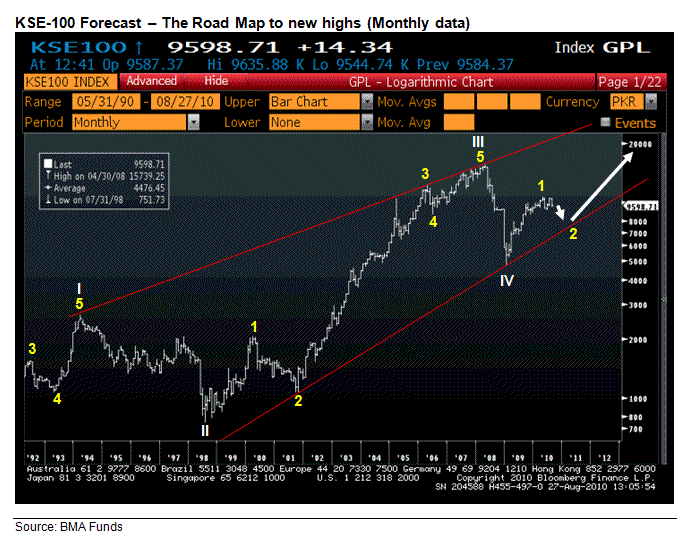
Over the coming months conditions in Pakistan will worsen for the short to medium term during which the country will be at a heightened risk of another regime change. We strongly believe that over the next few months Pakistan will present savvy investors with a major opportunity to buy and hold Pakistan on a 3 to 5yr view.
KSE100 - GBP

KSE100 - USD
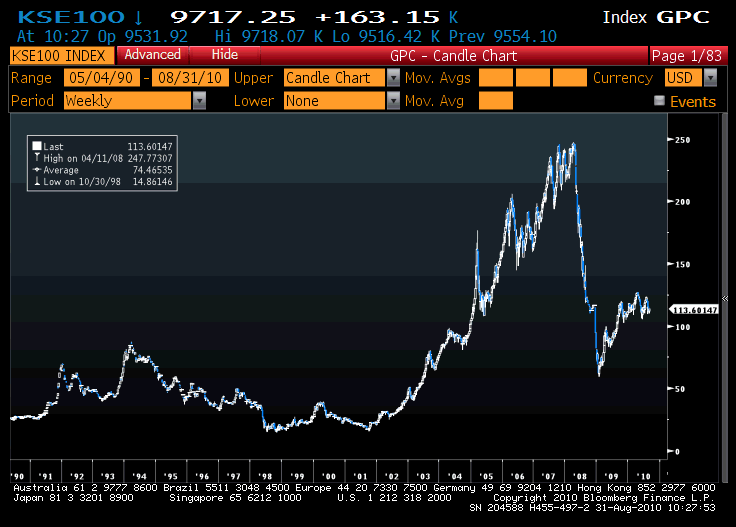
Bilal Khan
Fund Manager
BMA Funds: Contact Persons
Muddassar M. Malik mmm@bmafunds.com
Iffat Mankani iffat.mankani@bmafunds.com
Bilal Khan bilal.khan@bmafunds.com
General Email pakfunds@bmafunds.com
© 2010 Copyright BMA CAPITAL - All Rights Reserved
Disclaimer
This presentation is for market research purposes only. It is not an offer of securities and must not be construed as an offer to sell or an invitation to subscribe to any securities or other financial products in any jurisdiction or country. Investment in BMA Pakistan Opportunities Fund can only be made by completing an application form attached to the appropriate offer document. Information contained in this document is not intended to be securities or financial product advice and should not be relied upon as such. The repayment of an investment in and the performance of funds managed by BMA Asset Management Limited is not guaranteed by BMA Asset Management Limited, any organisation or any person. The potential investment is subject to investment risk, including possible delays in repayment and loss of income and principal invested. Past performance is not indicative of or a guarantee of future results. This presentation is intended as a general outline only and is not a definitive statement on the subject matter.
© 2005-2022 http://www.MarketOracle.co.uk - The Market Oracle is a FREE Daily Financial Markets Analysis & Forecasting online publication.



